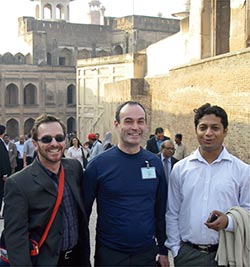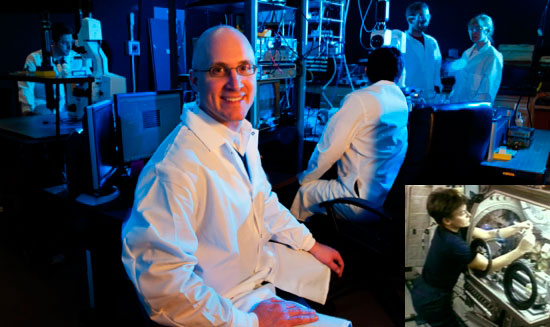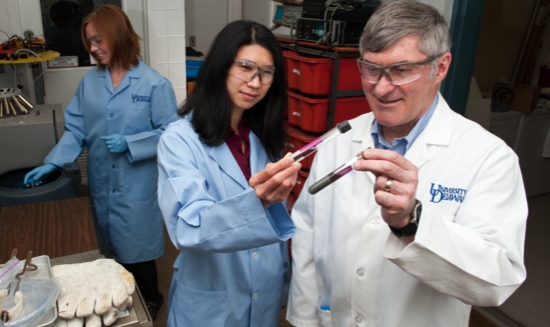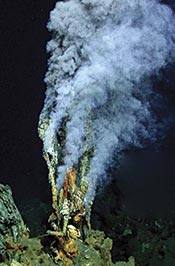


When researchers began exploring nanoscience more than a half-century ago, the field’s potential captured the imagination. Engineer Eric Drexler famously described a “grey goo” of self-replicating machines that could spin out of control in his 1986 book Engines of Creation. Writers such as Michael Crichton followed up with scenarios of nano-sized robots turning against mankind. Such hypotheticals have stayed in the realm of science fiction, but they beg an important question: What are the ethics of nanoscience research?
UD’s new Center for Science, Ethics and Public Policy (SEPP) launched last fall, in part, to help students and scientists navigate the implications of emerging research in a responsible manner. Engineering at the nanoscale, or one billionth of a meter, can create materials with improved performance that are stronger, lighter and more effective. The possible upsides have driven much of the research and development focus in the United States and abroad as nanotechnology began really taking off in the past decade.
“There is a great deal of promise of good things that could happen as a result of nanomaterials, but they have to be developed in a deliberate and thoughtful way,” SEPP Director Tom Powers says. “There has to be more of a dialogue between scientists, engineers and those who study the human health and environmental consequences of new technologies.”
Nanoparticles’ small size is key to both their usefulness and their potential danger, Powers says. Small enough to enter cells, manufactured nanoparticles have raised concerns about toxicity, such as by lodging into the lungs in a way similar to asbestos or by entering plants through the root systems. Researchers are not yet certain how the tiny particles circulate and accumulate in various environments — or even how to detect their presence.
Beyond potential health and environmental effects, there may be untoward ramifications of products that nanotechnology engineering could make possible, such as microscopic surveillance tools or surreptitious weapons.
Funded in part by the National Science Foundation, an interdisciplinary team of researchers is supporting nanotechnology education at UD, with an emphasis on applications in alternative energy research. Together with Ismat Shah, professor of materials science and engineering and professor of physics and astronomy, Powers created a course on nanoscience ethics and held a campuswide workshop on the topic. In November 2011, they helped organize international conferences on nanoethics in Pakistan and the United Arab Emirates.
Scientists are open to talking about the risks and benefits associated with nanotechnology, Powers says, but many have put much more thought into their research and manufacturing applications. Moving forward, SEPP encourages improved public communication about the benefits and risks of nanotechnology to inform discussions about manufacturing, commercialization and appropriate regulations and standards — starting with students at UD.
“Many of them will go on eventually to graduate work,” Powers says. “I hope they’ll remember that they actually can do nanoengineering and worry about the ethical, social, political and legal implications of what they’re doing at the same time.”

Eric Furst is intent on advancing the science of the super-small, and not even Earth’s gravity can hold him back.
From his office in UD’s Department of Chemical and Biomolecular Engineering, Furst has directed astronauts aboard the International Space Station (ISS) in some of the first nanoscience experiments in space.
Furst’s focus is colloids — otherwise known as emulsions or suspensions — materials that are part solid and part liquid. You know them as paint, glue, egg whites, gels, milk, even blood.
He is exploring colloids at the nanoscale to reveal their physics. Ultimately, his goal is to identify how nano-“building blocks” of various shapes and chemistries can be directed to “self-assemble” into specific structures with desired functions. Such “smart materials” could endow a robot, for example, with the dexterity to be able to pick up an item as fragile as an egg.

In 2007, he won a NASA research grant to explore materials called magnetorheological (MR) fluids as part of a program called InSPACE (Investigating the Structure of Paramagnetic Aggregates from Colloidal Emulsions).
If you subject MR fluids to a magnetic field, they morph into a solid. Iron nanoparticles dispersed inside form microscopic lattices that cause the suspensions to stiffen. Once the magnetic field is removed, the solid amazingly transitions back to a fluid again.
Studying MR fluids on Earth is difficult because although small magnetic particles remain in suspension, large particles sink due to Earth’s gravity. The low gravity aboard the ISS eliminates this effect.
Furst was ecstatic when the space shuttle Discovery lifted off in October 2007 to transport his first experiments to the ISS: “I was like a 7-year old. I even took my dad to the launch,” he says with a grin.
Space Station Commander Peggy Whitson conducted many of the UD experiments in the ISS Microgravity Science Glovebox, as Furst and postdoctoral researcher Paula Vasquez watched from UD via a video link. Furst even spoke with Whitson over the phone when questions arose.
Samples in capillary tubes were placed between electromagnets called Helmholtz coils, on which two microscopes were focused. The suspensions were studied under a toggled magnetic field for one to three hours to gain insight into their long-term behavior. More than 40 runs were done over several months.
“What we learned is that these suspensions follow a phase transition that no one had ever seen before,” Furst says.
Morphing from a fluid to amorphous solid and finally an ordered crystal, millions of MR particles came together as highly ordered “colloidal droplets.” Experiments aboard the ISS this summer will probe these droplets, with the aid of the crew and postdoctoral researcher James Swan.
Understanding how to precisely control the states and properties of MR fluids could yield new applications in space and on Earth, Furst points out, from increasing the mobility of space rovers for delving into distant planets, to improving the design of earthquake-resistant structures.
And the applications are ever-expanding. With the basic principles of directed self-assembly decoded on the ISS, his team is creating materials from more complex nano-building blocks — doublets he calls “smashed spheres,” and titania ellipsoids, shaped like rice, but 10,000 times smaller.
With these infinitesimal components, Furst’s lab already has created novel functional nanomaterials for use in optical communication systems and as thermal coatings, with the support of the Department of Energy and the National Science Foundation.
“The sky’s the limit!” Furst says.


Look at the tip of that old pencil in your desk drawer, and what you’ll see are layers of graphite that are thousands of atoms thick. Use the pencil to draw a line on a piece of paper, and the mark you’ll see on the page is made up of hundreds of one-atom layers.
But when UK scientists found a way — using, essentially, a piece of ordinary sticky tape — to peel off a layer of graphite that was just a single atom thick, they called the two-dimensional material graphene and, in 2010, won the Nobel Prize in physics for the discovery.
Now, researchers at the University of Delaware have conducted high-performance computer modeling to investigate a new approach for ultrafast DNA sequencing based on tiny holes, called nanopores, drilled into a sheet of graphene. Such quick and low-cost (estimated at less than $1,000) sequencing could usher in an era of personalized medicine, says Branislav Nikolic, associate professor of physics and astronomy.
“Graphene is a two-dimensional sheet of carbon atoms arranged in a honeycomb pattern,” he says. “The mechanical stability of graphene makes it possible to use an electron beam to sculpt a nanopore in a suspended sheet, as demonstrated in 2008 by Marija Drndić at the University of Pennsylvania.”
Graphene has been among the fastest-growing areas of study in nanoscience and technology over the past five years, Nikolic says, calling it a wonder material that has remarkable mechanical, electronic and optical properties.
In the new device concept proposed by Nikolic’s team, a tiny hole a few nanometers in diameter is drilled into a sheet of graphene and DNA is threaded through that nano-pore. Then, a current is used to detect the presence of different DNA bases within the nanopore. The process uses graphene nanoribbons — thin strips of graphene that are less than 10 nanometers wide and have edges made up of a specific zigzag arrangement of carbon atoms.
Nikolic says that he and postdoctoral researcher Kamal Saha used knowledge acquired from several years of theoretical and computational research on the electronic transport in graphene to increase the magnitude of the detection current in their biosensor by a thousand to a million times when compared to other recently considered devices.
Nikolic, Saha and Drndić recently published the results of the computer modeling in the journal Nano Letters, published by the American Chemical Society. Colleagues, led by Drndić at Penn, will now seek to fabricate the biosensors in their lab, guided by the simulations.
In June, in Pisa, Italy, a workshop organized by Nikolic and sponsored by the Centre Européen de Calcul Atomique et Moléculaire, brought together leading experts in computational modeling and investigation of nanodevices for third-generation DNA sequencing technologies.

At the bottom of the ocean, cracks in the seafloor release heat and minerals from within Earth’s crust. These hydrothermal vents support life nearby that would otherwise struggle for survival at such cold, dark depths. Yet UD researchers discovered that the vents may also help nourish organisms thousands of miles away by emitting an important iron source: pyrite nanoparticles.
Measuring only 200 nanometers in size, or roughly one-thousandth the diameter of a human hair, the tiny pieces of pyrite are highly buoyant and can readily disperse into the ocean. Composed of iron and sulfur, pyrite reacts slowly with oxygen in water to rust into oxidized iron, which can then be absorbed by bacteria, plankton, fish and other sea life as a trace nutrient.
“Almost any organism in the ocean is going to need iron,” said George W. Luther, Maxwell P. and Mildred H. Harrington Professor of Oceanography, who reported the findings in Nature Geoscience with his former graduate student Mustafa Yücel in May 2011.

While pyrite, called “fool’s gold” for its shiny surface, was previously known to gush out of hydrothermal vents, scientists thought it emerged only as much larger, heavier pieces that rapidly fell back down on the ocean floor. Luther’s group found that as much as 10 percent of the iron coming out of hydrothermal vents is nanoparticulate pyrite.
At that extremely small size, pyrite may travel up to 4,000 kilometers away through the ocean based on independent analyses of dissolved iron concentrations by other scientists. Given the substance’s slow oxidation rate, pyrite-generated iron can get released in remote parts of the deep sea, akin to time-release capsules.
Finding the nanoparticles in the ocean’s depths was no small feat. In partnership with Woods Hole Oceanographic Institution, UD researchers used remote-controlled titanium samplers, which can withstand the brutally hot temperatures at the hydrothermal vents, to obtain samples from vent plumes 1,800 to 4,000 meters deep in the Pacific. In addition to wet chemical analyses, they used scanning and transmission electron microscopy to closely examine the contents back in the lab.
The findings were part of a broader research project examining how temperature and chemical content in seawater dictates what type of animals thrive in deep-sea environments near hydrothermal vents, such as snails, tubeworms, mussels and other organisms. A chemist by training, Luther focuses his research on the interface between chemistry and biology, with the position that the former drives the latter.
Funded by the National Science Foundation, he will continue the nanoparticle research with colleagues this fall on an excursion to the Mid-Atlantic Ridge to study hydrothermal vents there.
“One of the ideas that we’ve been exploring is that it’s not only iron that’s being transported, but copper, zinc and other elements as well,” Luther said.